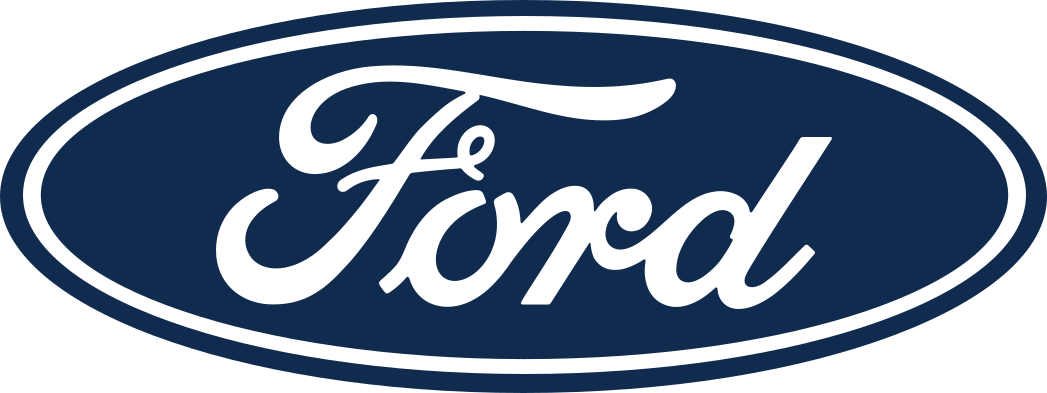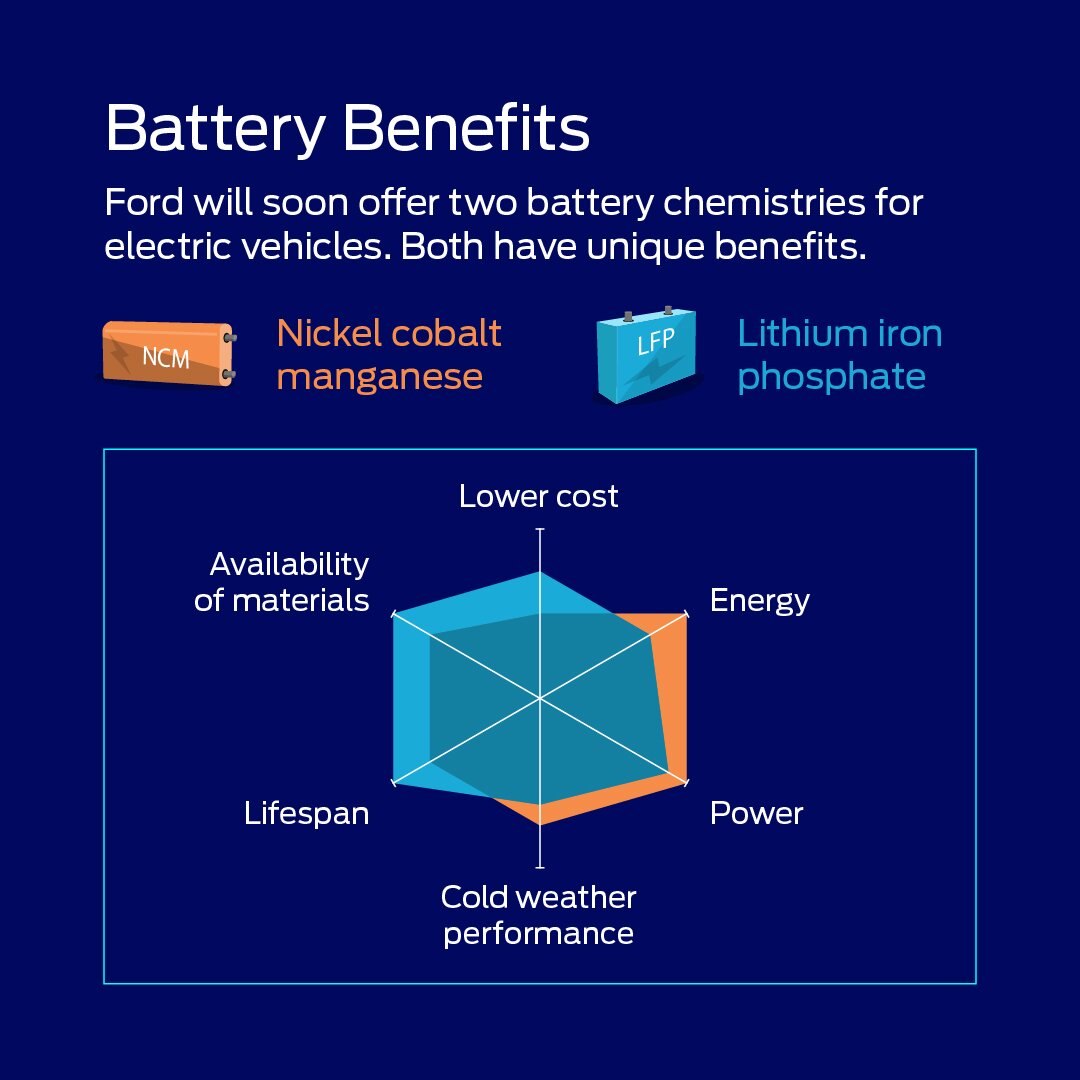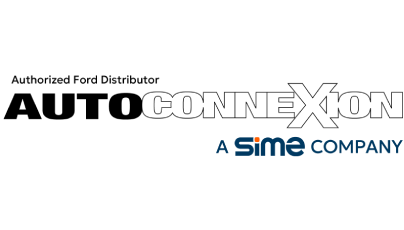FORD TAPS MICHIGAN FOR NEW LFP BATTERY PLANT; NEW BATTERY CHEMISTRY OFFERS CUSTOMERS VALUE, DURABILITY, FAST CHARGING, CREATES 2,500 MORE NEW AMERICAN JOBS
- Ford is the first automaker to commit to build both nickel cobalt manganese (NCM) and lithium iron phosphate (LFP) batteries in the U.S., helping America’s No. 2 EV company in 2022 bring EVs to more customers and diversify its U.S. supply chain
- Ford is investing $3.5 billion to build an LFP battery plant in Marshall, Michigan; this wholly owned subsidiary is part of Ford’s $50 billion+ global push to lead the EV revolution. Initial production slated for 2026 with 2,500 employees to start
- Adding LFP batteries to Ford’s EV lineup this year – starting with Mustang Mach-E – and backing a U.S. LFP battery plant are key parts of the company’s Ford+ plan; this helps Ford scale more quickly, making EVs more accessible and affordable for customers
- LFP batteries are exceptionally durable using fewer high-demand, high-cost materials and will help power a variety of Ford’s next-generation of EV passenger vehicles and pickups; new LFP plant will add approximately 35 gigawatt hours (GWh) of LFP battery capacity
- Ford and its battery tech collaborators have announced $17.6 billion in investment in EV and battery production in the United States since 2019, leading to more than 18,000 direct jobs in the U.S. and more than 100,000 indirect jobs
MARSHALL, Mich., Feb. 13, 2023 – Building on Ford’s commitment to American manufacturing, Ford announced today it is investing $3.5 billion to build the country’s first automaker-backed LFP battery plant, offering customers a second battery technology within Ford’s EV lineup.
This plant – called BlueOval Battery Park Michigan – initially will employ 2,500 people when production of LFP batteries begins in 2026. Ford will have the option to further grow its battery capacity at its Marshall, Michigan, plant, which will be part of a wholly owned Ford subsidiary.
With this $3.5 billion investment, Ford and its battery tech collaborators have announced $17.6 billion in investments in electric vehicle and battery production in the United States since 2019, as part of the company’s commitment to invest over $50 billion in electric vehicles globally through 2026. In the next three years, these investments will lead to more than 18,000 direct jobs in Michigan, Kentucky, Tennessee, Ohio and Missouri and more than 100,000 indirect jobs, according to the methodology from a 2020 independent study.
“We are committed to leading the electric vehicle revolution in America, and that means investing in the technology and jobs that will keep us on the cutting edge of this global transformation in our industry,” said Bill Ford, Ford executive chair. “I am also proud that we chose our home state of Michigan for this critical battery production hub.”
Diversifying and localizing Ford’s battery supply chain in the countries where it builds EVs will improve availability and affordability for customers while strengthening consumer demand. Ford is working to deliver an annual run rate of 600,000 electric vehicles globally by the end of this year and 2 million globally by the end of 2026 as part of its Ford+ plan.
As the company rapidly scales EV production, introducing LFP batteries allows Ford to produce more electric vehicles and offer more choices to new EV customers, and helps support the company’s goal of an 8 percent EBIT margin for Model e by 2026.
###
*Survey conducted on behalf of Ford Pro by PSB, a modern global research insights consultancy, in the United States, United Kingdom and Germany among 1,250 corporate fleet decision makers from Dec. 14-23, 2021.
**Ford Pro Charging depot software subscription and Ford Telematics subscription required. Chargers must conform to Open Charge Point Protocol 1.6-J industry standard and be internet-connected. Ford Telematics requires modem activation or plug-in device purchase and activation for non-Ford electric vehicles. Ford Pro Charging depot software, Ford Telematics and Ford Data Services are subscription service subject to agreement to Ford Smart Mobility terms and conditions. Subscription subject to monthly charge. Subject to OFAC and credit check for subscription eligibility. Connected service and features, and access to vehicle and charger data depend on subscription and compatible cellular network availability. Evolving technology/cellular networks/vehicle and charger capability may limit functionality and prevent operation of connected features.
†Eligible vehicles receive a complimentary three-year trial of E-Telematics services that begins on the new vehicle warranty start date. Requires modem activation. Terms and conditions apply. Telematics service and features, and access to vehicle data depend on compatible AT&T network availability. Evolving technology/cellular networks/vehicle capability may limit functionality and prevent operation of connected features. After the three-year trial, annual service contract is required for E-Telematics service. Go to Fordpro.com or call 833.811.3673 to activate E-Telematics service.
*Available on vehicles with embedded modem or equipped with plug-in device (PID). Requires modem activation. Ford Telematics and Ford Data Services are subscription services subject to agreement to FSM terms and conditions. Subscription subject to monthly charge. Subject to OFAC and credit check for subscription eligibility. Connected service and features, and access to vehicle data depend on subscription and compatible AT&T network availability. Evolving technology/cellular networks/vehicle capability may limit functionality and prevent operation of connected features.
**Disclaimer - Based on original equipment manufacturers(OEM)/automotive manufacturers that sell all-electric vehicles and have publicly announced charging networks. Department of Energy data used. FordPass, compatible with select smartphone platforms, is available via a download. Message and data rates may apply.
***Available on vehicles with embedded modem or equipped with approved plug-in device (PID). May require modem activation. Ford Telematics and Ford Data Services require a purchased subscription. Terms and conditions apply. Telematics service and features, and access to vehicle data depend on subscription and compatible AT&T network availability. Evolving technology/cellular networks/vehicle capability may limit functionality and prevent operation of connected features.
# # #
Note: IHS Markit global vehicle registrations are compiled from government and other sources and capture 95 percent of global new vehicle volumes in more than 80 countries. Sports cars, as defined by IHS Markit, include all vehicles in the IHS Markit Global Sports Car segment. Mustang is America’s best-selling sports car over the last 50 years, based on Ford analysis of 1966-2018 total U.S. new vehicle cumulative registrations for all sports car segments supplied by IHS Markit.
###
*Survey conducted on behalf of Ford Pro by PSB, a modern global research insights consultancy, in the United States, United Kingdom and Germany among 1,250 corporate fleet decision makers from Dec. 14-23, 2021.
**Ford Pro Charging depot software subscription and Ford Telematics subscription required. Chargers must conform to Open Charge Point Protocol 1.6-J industry standard and be internet-connected. Ford Telematics requires modem activation or plug-in device purchase and activation for non-Ford electric vehicles. Ford Pro Charging depot software, Ford Telematics and Ford Data Services are subscription service subject to agreement to Ford Smart Mobility terms and conditions. Subscription subject to monthly charge. Subject to OFAC and credit check for subscription eligibility. Connected service and features, and access to vehicle and charger data depend on subscription and compatible cellular network availability. Evolving technology/cellular networks/vehicle and charger capability may limit functionality and prevent operation of connected features.
†Eligible vehicles receive a complimentary three-year trial of E-Telematics services that begins on the new vehicle warranty start date. Requires modem activation. Terms and conditions apply. Telematics service and features, and access to vehicle data depend on compatible AT&T network availability. Evolving technology/cellular networks/vehicle capability may limit functionality and prevent operation of connected features. After the three-year trial, annual service contract is required for E-Telematics service. Go to Fordpro.com or call 833.811.3673 to activate E-Telematics service.
*Available on vehicles with embedded modem or equipped with plug-in device (PID). Requires modem activation. Ford Telematics and Ford Data Services are subscription services subject to agreement to FSM terms and conditions. Subscription subject to monthly charge. Subject to OFAC and credit check for subscription eligibility. Connected service and features, and access to vehicle data depend on subscription and compatible AT&T network availability. Evolving technology/cellular networks/vehicle capability may limit functionality and prevent operation of connected features.
**Disclaimer - Based on original equipment manufacturers(OEM)/automotive manufacturers that sell all-electric vehicles and have publicly announced charging networks. Department of Energy data used. FordPass, compatible with select smartphone platforms, is available via a download. Message and data rates may apply.
***Available on vehicles with embedded modem or equipped with approved plug-in device (PID). May require modem activation. Ford Telematics and Ford Data Services require a purchased subscription. Terms and conditions apply. Telematics service and features, and access to vehicle data depend on subscription and compatible AT&T network availability. Evolving technology/cellular networks/vehicle capability may limit functionality and prevent operation of connected features.
# # #
Note: IHS Markit global vehicle registrations are compiled from government and other sources and capture 95 percent of global new vehicle volumes in more than 80 countries. Sports cars, as defined by IHS Markit, include all vehicles in the IHS Markit Global Sports Car segment. Mustang is America’s best-selling sports car over the last 50 years, based on Ford analysis of 1966-2018 total U.S. new vehicle cumulative registrations for all sports car segments supplied by IHS Markit.
LFP Battery Chemistry to Benefit Ford Customers
Offering LFP as a second battery chemistry – in addition to nickel cobalt manganese (NCM) – allows Ford customers to choose an electric vehicle with unique battery performance characteristics most aligned with their needs.
Offering LFP as a second battery chemistry – in addition to nickel cobalt manganese (NCM) – allows Ford customers to choose an electric vehicle with unique battery performance characteristics most aligned with their needs.
LFP batteries are very durable and tolerate more frequent and faster charging while using fewer high-demand, high-cost materials. This lower-cost battery, at scale, will help Ford contain or even further reduce EV prices for customers. These LFP batteries will power a variety of affordable, next-generation Ford EV passenger vehicles and trucks under development, most of which will be assembled in the U.S.
“Ford’s electric vehicle lineup has generated huge demand. To get as many Ford EVs to customers as possible, we’re the first automaker to commit to build both NCM and LFP batteries in the United States,” said Jim Farley, Ford president and CEO. “We’re delivering on our commitments as we scale LFP and NCM batteries and thousands, and soon millions, of customers will begin to reap the benefits of Ford EVs with cutting-edge, durable battery technologies that are growing more affordable over time.”
Even before the new battery plant opens, Ford will introduce LFP batteries on Mustang Mach-E this year and F-150 Lightning in 2024 to increase production capacity, with a goal of reducing wait times for customers.
LFP Battery Chemistry to Benefit Ford Customers
Offering LFP as a second battery chemistry – in addition to nickel cobalt manganese (NCM) – allows Ford customers to choose an electric vehicle with unique battery performance characteristics most aligned with their needs.
LFP batteries are very durable and tolerate more frequent and faster charging while using fewer high-demand, high-cost materials. This lower-cost battery, at scale, will help Ford contain or even further reduce EV prices for customers. These LFP batteries will power a variety of affordable, next-generation Ford EV passenger vehicles and trucks under development, most of which will be assembled in the U.S.
“Ford’s electric vehicle lineup has generated huge demand. To get as many Ford EVs to customers as possible, we’re the first automaker to commit to build both NCM and LFP batteries in the United States,” said Jim Farley, Ford president and CEO. “We’re delivering on our commitments as we scale LFP and NCM batteries and thousands, and soon millions, of customers will begin to reap the benefits of Ford EVs with cutting-edge, durable battery technologies that are growing more affordable over time.”
Even before the new battery plant opens, Ford will introduce LFP batteries on Mustang Mach-E this year and F-150 Lightning in 2024 to increase production capacity, with a goal of reducing wait times for customers.
Commitment to American Manufacturing
This all-new battery production facility in Michigan will add approximately 35 gigawatt hours per year of new battery capacity for Ford in the U.S. initially – capable of powering approximately 400,000 future Ford EVs.
“Ford’s $3.5 billion investment creating 2,500 good-paying jobs in Marshall building electric vehicle batteries will build on Michigan’s economic momentum,” said Michigan Governor Gretchen Whitmer. “Today’s generational investment by an American icon will uplift local families, small businesses, and the entire community and help our state continue leading the future of mobility and electrification. Let’s continue bringing the supply chain of electric vehicles, chips, and batteries home while creating thousands of good-paying jobs and revitalizing every region of our state. Since I took office, we’ve secured over 30,000 auto jobs and landed multiple electric vehicle and chip-making factories. We’re on the move, so let’s keep our foot on the accelerator.”
As part of Ford’s plan to offer a new battery chemistry and source in key regions where it produces EVs, Ford has reached a new agreement with Contemporary Amperex Technology Co., Limited (CATL) – the world’s leading battery manufacturer. Under the arrangement, Ford’s wholly owned subsidiary would manufacture the battery cells using LFP battery cell knowledge and services provided by CATL, which has operated 13 plants in Europe and Asia.
Ford engineers will integrate these LFP battery cells into its vehicles. This new agreement with CATL adds to Ford’s existing battery capacity and available battery technology made possible through a series of key collaborations – including with SK On and LG Energy Solution (LGES).
Sustainable EV Supply Chain
LFP battery technology helps reduce reliance on critical minerals such as nickel and cobalt and is in line with Ford’s work to create an EV supply chain that upholds its commitments to sustainability and human rights.
Ford already has committed to achieving carbon neutrality globally across its vehicles, operations and supply chain by 2050. Ford was among the first American automakers to align with the international community to limit the impacts of global warming as part of the Paris Agreement and joined RouteZero, a global coalition working toward zero-emission cars and vans globally by 2040 and in leading markets like the U.S., Europe and China by 2035. Ford also was the first U.S. automaker to release a human rights report.
Community Support
The company is ensuring that 245 acres at the southern edge of the site are placed into a conservation easement. This land, along the Kalamazoo River, will be preserved for generations to come and protected against future industrial development. Ford will work with government officials and community leaders to preserve natural resources and recreation near the facility, as part of its commitment to being a good neighbor. The Ford Fund also will contribute resources to help the community explore how to best enjoy this beautiful land.
“The City of Marshall welcomes this exciting new partnership with Ford Motor Company,” said Marshall Mayor Jim Schwartz. “This investment in the local community will lead to an influx of new jobs to Marshall and economic development throughout the area. We are especially excited to support Ford’s conservation easement which will preserve Michigan’s natural beauty along the Kalamazoo River.”
###
For Aftersales / Parts / Warranty enquiries, contact our Customer Care Centre at 1300 383 181 Monday – Friday 9AM to 5PM (excluding public holidays) or email customercare.sdac@simedarby.com.
Click the button below to get the conversation started.


.JPG)
.JPG)
.JPG)
.JPG)
.JPG)
.jpg)
.JPG)
.JPG)
.JPG)
.JPG)
.JPG)
.JPG)
